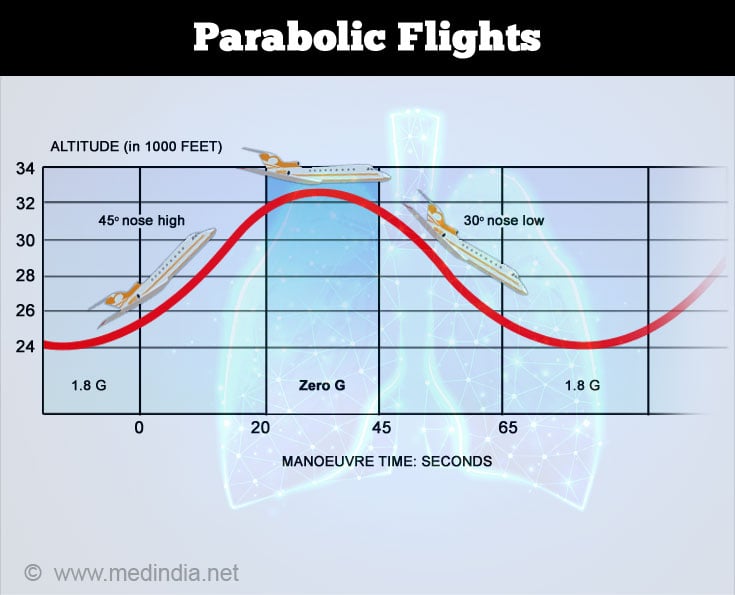- Chest Wall Mechanics in Microgravity: Results from Parabolic Flights - (http://adsabs.harvard.edu/full/1994esasp.366..307p)
- Lung Volumes during Sustained Microgravity on Spacelab SLS-1 - (https://www.ncbi.nlm.nih.gov/pubmed/7836229)
- Inhomogeneity of Pulmonary Perfusion during Sustained Microgravity on SLS - (https://journals.physiology.org/doi/abs/10.1152/jappl.1994.76.4.1730?journalCode=jappl)
- Inhomogeneity of Pulmonary Ventilation during Sustained Microgravity as Determined by Single-breath Washouts - (https://journals.physiology.org/doi/abs/10.1152/jappl.1994.76.4.1719)
- Pulmonary Diffusing Capacity and Pulmonary Capillary Blood Volume during Parabolic Flights - (https://www.ncbi.nlm.nih.gov/pubmed/9104844)
- Pulmonary Diffusing Capacity, Capillary Blood Volume, and Cardiac Output during Sustained Microgravity - (https://www.ncbi.nlm.nih.gov/pubmed/8376261)
About
Human anatomy and physiology have been molded and shaped by Earth’s gravity over millions of years. It is not surprising therefore that when this gravity is removed, for example when an astronaut goes into space, every single system in the body is affected in some way, including the respiratory system. The changes that occur when exposed to short- and long-term microgravity ( when things seem to be weightless; micro=‘very small’ ) can be better understood by conducting research in ground-based space simulations, on parabolic flights, and during actual space missions.
The primary organs of the respiratory system are the lungs, and both the volume and capacity of human lungs are known to change when in microgravity, something that has been studied through parabolic flight experiments. Parabolic flights are used as a gateway to study weightlessness. These special flights, known more colloquially as ‘vomit comets’, due to the number of people on them who experience feelings of nausea and vomiting, are able to simulate for short periods of time the same sensation of weightlessness felt by astronauts in space. This makes parabolic flights a useful option for training astronauts and conducting a variety of research experiments.
Gravity-free conditions are reproduced by this specially adapted aircraft by conducting a series of alternating upward and downward arcs (parabolas), interspersed with level flight, rather like the ups and downs of a roller coaster. Each parabola is made up of three very restricted phases lasting approximately 20 seconds each resulting in changes in gravity:
- Phase 1 - plane nose pulled up and the aircraft heads up at a 45 degree angle – generating hyper-gravity (almost 2Gs);
- Phase 2 - the aircraft is ‘pushed over’ the top of the hill, during which zero-gravity is achieved until the aircraft is headed 30 degrees nose down;
- Phase 3 - Generating hyper-gravity once again until the plane is leveled out or a horizontal position is attained.

What has been confirmed in parabolic flight is that the sternum of the chest shifts in an upwards direction and is accompanied by an increase in diameter of the lower rib cage when in microgravity. This change in the position of the chest wall was predicted to cause the volume-pressure curve to lie between the standing upright and the supine position curves, with the net result being a reduction in lung volumes.
Research conducted with five participants on a KC-135 aircraft parabolic flight found that the functional residual capacity in the lungs decreased by 432 ml during microgravity. Vital capacity also reduced from a mean value of 4.72 L at 1 G to 4.35 L at 0G. Forced vital capacity and forced expiratory volume in 1s were also decreased by an average of 2.5% in the 20 seconds of microgravity.(1✔ ✔Trusted Source
Chest Wall Mechanics in Microgravity: Results from Parabolic Flights
Go to source)
In further research that took place over a 9-day mission onboard the SpaceLab Space Life Sciences-1, forced vital capacity and forced expiratory volume in 1 second were significantly reduced on flight day 2, but were greater than pre-flight values at day 9. In comparison with standing pre-flight values, tidal volume was decreased by 15% (110 ml) in microgravity and this reduction remained during the entire space flight.
Functional residual capacity and expiratory reserve volume decreased significantly in-flight by 520 ml and 370 ml, respectively, when compared with pre-flight standing values. Residual volume was less during flight by 350 ml, when compared with standing control values. This 20% reduction in the residual volume was unexpected as it is normally fairly resistant to change. Lung volumes are believed to be affected by the changes in the intra-thoracic blood volume that occurs throughout a mission, and by alterations in respiratory mechanics and the upward displacement of the diaphragm and abdominal content that happens in the absence of gravity.(2✔ ✔Trusted Source
Lung Volumes during Sustained Microgravity on Spacelab SLS-1
Go to source)
How Do Ventilation and Perfusion in the Lungs Respond to Microgravity?
The gravitational gradient affects the distribution of ventilation and perfusion in the upright human lung. This uneven distribution of ventilation and blood flow within the lungs leads to variations in ventilation-perfusion ratios. It has been found that cardiogenic oscillations of CO2 decrease to approximately 60% in amplitude in microgravity(3✔ ✔Trusted Source
Inhomogeneity of Pulmonary Perfusion during Sustained Microgravity on SLS
Go to source), while a significant reduction in cardiogenic oscillations of nitrogen (to 44%) and argon (to 24%) have also been seen in comparison to pre-flight standing values(4✔ ✔Trusted Source
Inhomogeneity of Pulmonary Ventilation during Sustained Microgravity as Determined by Single-breath Washouts
Go to source). Possible causes of the residual inhomogeneity of ventilation include regional differences in lung compliance, airway resistance and the motion of the chest wall and diaphragm. Microgravity was expected to abolish completely apico-basal differences in perfusion and its persistence may possibly be related to other mechanisms not affected by gravity, such as central-peripheral differences in blood flow and interregional differences in conductance.
Is Gas Exchange Affected during a Space Mission?
The diffusion capacity of the lung increased by 62% in a parabolic flight study and by 28% in sustained microgravity when values were compared with pre-flight standing figures. The standing-to-supine transition pre- and post-flight caused a significant elevation in blood volume in pulmonary capillaries. The diffusing capacity of the membrane was unchanged pre-flight in the standing-to-supine transition and significantly elevated in-flight in comparison to standing (27%) and supine (21%). In microgravity, capillary filling is uniform, which is associated with a large increase in the surface area of the blood-gas barrier. Consequently, the membrane diffusing capacity is substantially raised. This suggests an absence of sub-clinical interstitial pulmonary edema in microgravity, as had been previously speculated.(5✔ ✔Trusted Source
Pulmonary Diffusing Capacity and Pulmonary Capillary Blood Volume during Parabolic Flights
Go to source, 6✔ ✔Trusted Source
Pulmonary Diffusing Capacity, Capillary Blood Volume, and Cardiac Output during Sustained Microgravity
Go to source)
What we have learned from lung studies conducted on parabolic flights and on orbiting space stations is that although the absence of gravity affects the respiratory system, it does not in fact cause any deleterious effects to the gas exchange process in the lungs.
Section Editors Comments (This article was reviewed by Prof. K. Ganapathy)
We seldom realize that basic fundamental research is the precursor and is absolutely mandatory before its practical application in the real world. While astronauts bask in glory - and rightfully so - after their long sojourns for months in the International Space Station - we seldom give credit to the thousands of support staff, each of whose contributions is equally important. Space medicine will soon become a reality. We cannot however extrapolate existing fundamentals of human physiology to a micro-gravity environment.
Articles such as this may be difficult to comprehend, but serves to remind us that a journey of millions of miles (55 million miles to Mars at its nearest!) begins with this first step in our understanding of how human physiology will behave in the outer space. There is more to come in future articles.






